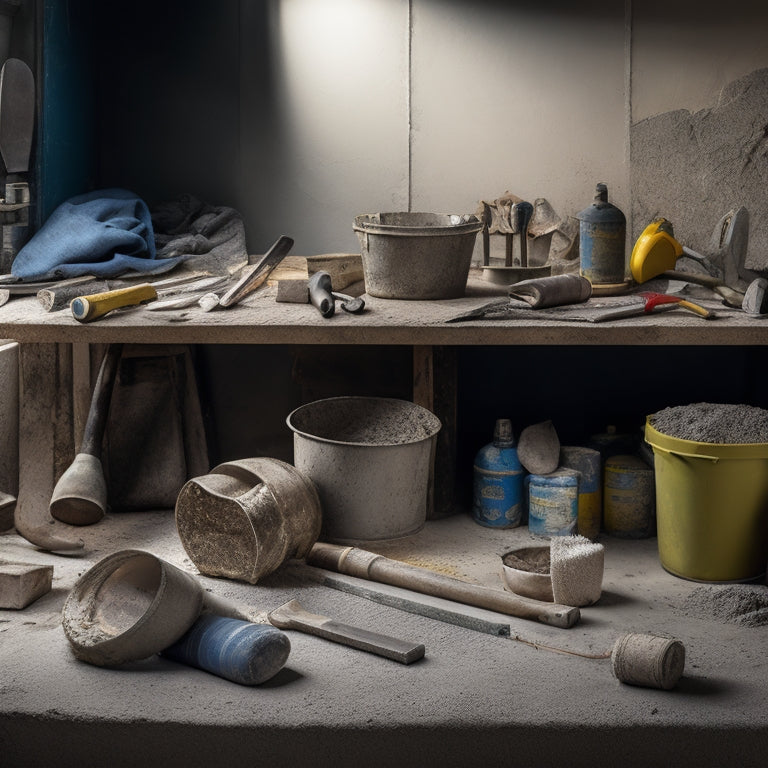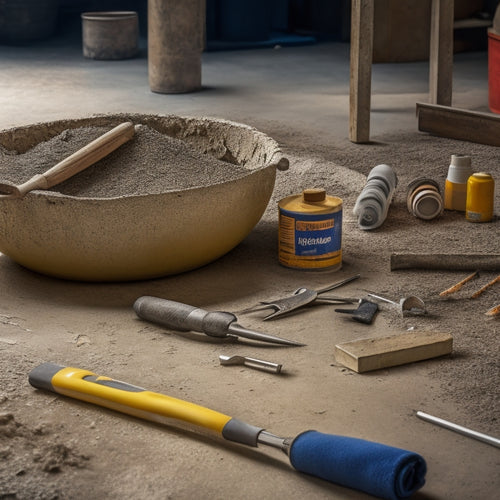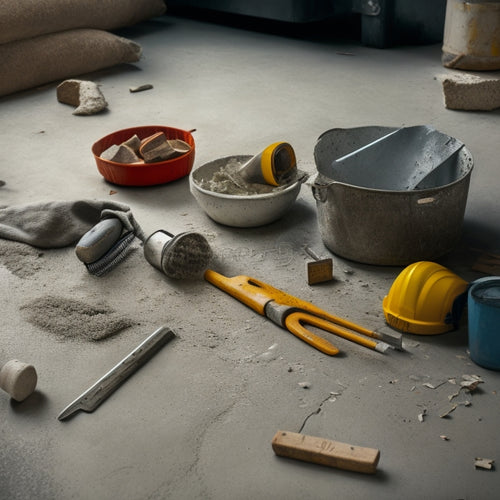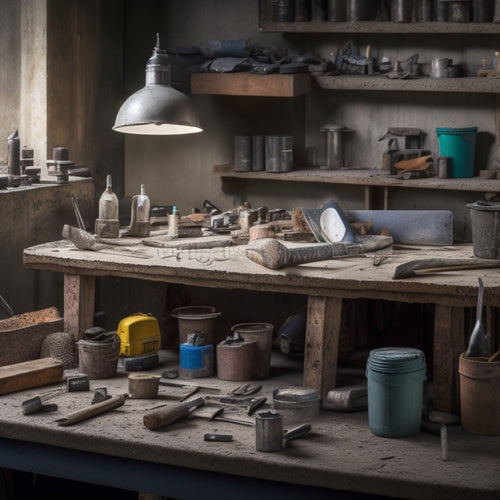
10 Must-Have Tools for DIY Concrete Finishing
Share
When tackling a DIY concrete finishing project, you'll need a range of essential tools to achieve a professional-looking finish. Start with concrete finishing tools like trowels, edger tools, and finishing floats for applying and smoothing the final layer. Cutting tools like precision cutting edges and diamond blades help shape the concrete. Grinder options and polishing pads are vital for achieving a high-gloss finish. Don't forget measuring and pouring equipment, concrete sealer application tools, and safety gear like goggles, masks, and gloves. With these must-haves in your toolkit, you'll be well on your way to creating a flawless concrete surface, and a closer look at each of these tools will reveal the nuances that set professionals apart.
Key Takeaways
• Finishing trowels, edger tools, and finishing floats are essential for achieving a smooth, professional finish in DIY concrete projects.
• Precision cutting edges and diamond blades are critical for shaping concrete at edges and joints, and for cutting concrete efficiently.
• Grinders, polishing pads, and pad aggressiveness are necessary for grinding and polishing concrete surfaces to achieve a high-gloss finish.
• Mixers, measuring, and pouring equipment are vital for mixing and pouring concrete accurately and efficiently to prevent structural issues.
• Safety gear, including goggles, dust masks, gloves, and boots, is crucial for protecting yourself from injuries and hazards during DIY concrete finishing.
Concrete Finishing Trowel Essentials
You'll need a concrete finishing trowel that meets specific standards to achieve a smooth, even finish. There are different trowel types, each designed for specific tasks, such as bull floats, fresno trowels, and finishing trowels. For a DIY project, a finishing trowel is the most essential tool. It's used to apply and smooth out the final layer of concrete, removing any imperfections or air pockets.
When choosing a trowel, look for one made from high-quality materials, such as stainless steel or aluminum, that can withstand the rigors of concrete finishing. The handle should be ergonomic and comfortable to grip, reducing fatigue and improving control.
Mastering trowel techniques is vital for achieving a professional-looking finish. Practice different strokes, such as pushing, pulling, and feathering, to develop your skills. Always work in small sections, using long, smooth strokes to blend the concrete.
Remember to keep your trowel clean and well-maintained to prevent scratches and marks on the concrete surface.
Edger Tools for Smooth Finish
When you're working on a concrete project, you know that achieving a smooth finish requires precise control over the edges.
That's where edger tools come in, and you'll want to choose ones that offer advanced edge control systems to guarantee a professional-looking result.
Edge Control Systems
Edge control systems, comprising edger tools, are specifically designed to achieve a smooth finish by confining and shaping the concrete at the edges and joints of a slab or pavement. When you're working on a DIY concrete finishing project, these systems are essential for attaining professional-looking results. By using edge control systems, you can guarantee that your concrete edges are straight, clean, and free of defects.
You'll find that edge finishing techniques are greatly enhanced with the right edger tools. Edge alignment tools, for instance, help you achieve precise control over the concrete flow, allowing you to create sharp, defined edges. This is especially important when working with decorative concrete or exposed aggregate finishes, where imperfections can be glaringly obvious.
With edge control systems, you can confidently tackle complex edge profiles and joint layouts, knowing that your finished product will meet the highest standards of quality and safety. By incorporating these tools into your DIY concrete finishing arsenal, you'll be able to achieve a level of precision and control that's unmatched by manual methods alone.
Precision Cutting Edges
To achieve a smooth, blemish-free finish, precision cutting edges, specifically designed as edger tools, play an essential role in confining and shaping the concrete at the edges and joints of a slab or pavement.
These tools guarantee edge accuracy, allowing you to execute precise cutting techniques that result in a professional-looking finish.
When selecting edger tools, consider the following essential features:
-
Adjustable cutting depth: This feature allows you to customize the cutting depth to suit your specific project needs, guaranteeing a precise finish.
-
Durable cutting edges: High-quality cutting edges made from materials like diamond-coated steel or tungsten carbide will withstand the rigors of concrete cutting, reducing the risk of damage or breakage.
-
Ergonomic handle design: A comfortable, ergonomic handle design will reduce fatigue and improve control, enabling you to work safely and efficiently.
Smooth Finish Guarantee
With the right edger tool, you can confidently achieve a smooth, blemish-free finish, as these specialized tools are specifically designed to deliver precise control and accuracy at the concrete's surface. Edger tools are essential for achieving a professional-looking finish, and they're particularly useful for creating sharp, clean edges and joints.
When choosing an edger tool, consider the type of concrete you're working with, as well as the desired finish. For example, a walk-behind edger is ideal for large, flat areas, while a handheld edger is better suited for smaller, more intricate areas.
To guarantee a smooth finish, it's vital to master various smoothing techniques, such as floating and troweling. You should also invest in high-quality finishing products, like concrete sealers and curing compounds, to protect and enhance the finish.
Always follow safety guidelines when working with edger tools, including wearing protective gear like gloves and safety glasses. By combining the right edger tool with proper techniques and finishing products, you can achieve a flawless, professional-grade finish that will withstand the test of time.
Grinder Options for Polishing
You'll need to select a grinder that can effectively remove scratches and hazing, preparing your concrete surface for the next polishing stages. As you explore grinder options, take into account the type of polishing technique you'll be using and the level of finish you want to achieve.
Here are three key grinder types to take into account:
-
Angle grinders: Ideal for aggressive material removal and preparing surfaces for higher gloss finishes.
-
Floor grinders: Designed for large-scale surface preparation and polishing, these grinders are perfect for commercial or industrial projects.
-
Edge grinders: Specialized for working in tight spaces and corners, edge grinders are essential for achieving a professional finish.
When choosing a grinder, prioritize safety features, such as dust collection systems and adjustable handles, to minimize fatigue and prevent accidents. Additionally, verify you have the necessary personal protective equipment (PPE) and follow manufacturer guidelines to avoid injuries.
Concrete Sealer Application Tools
After achieving a high-quality, polished finish, apply a concrete sealer using the right application tools to protect and enhance the appearance of your concrete surface.
You'll need to choose the appropriate sealer type, such as acrylic, polyurethane, or epoxy, depending on the level of protection and sheen desired.
Next, select the application method that suits your project's requirements. You can use a roller extension pole for large areas, a lambswool applicator for a smooth, even finish, or a foam brush for detail work and edges.
When applying the sealer, always follow the manufacturer's instructions and take necessary safety precautions, such as wearing protective gloves, safety glasses, and a mask.
Verify the surface is clean, dry, and free of debris to achieve a strong bond between the sealer and concrete.
Apply the sealer in thin, even coats, allowing each coat to dry according to the manufacturer's instructions before applying the next.
Polishing Pads for High Gloss
When you're aiming for a high-gloss finish, selecting the right polishing pads is essential.
You'll need to take into account factors like pad material, bond type, and grit size to guarantee you're getting the desired results.
Pad Selection Criteria
Selecting the right polishing pad is essential to achieving a high-gloss finish, as it directly impacts the final result's quality and appearance. You'll want to choose a pad that can withstand the demands of the job, guaranteeing a consistent and efficient polishing process.
When selecting a polishing pad, consider the following key criteria:
-
Pad durability: A durable pad will last longer and perform consistently, reducing the need for frequent replacements and minimizing the risk of accidents.
-
Pad compatibility: Confirm the pad is compatible with your concrete type, as well as your polishing equipment and chemicals. Incompatible pads can lead to poor results, damage to your equipment, or even safety hazards.
-
Pad aggressiveness: Choose a pad with the right level of aggressiveness for your specific project. A pad that's too aggressive can damage the concrete, while one that's too gentle may not achieve the desired finish.
Grit Sequence Matters
You'll need to follow a specific grit sequence to achieve a high-gloss finish, as this systematic progression is essential for producing a flawless, reflective surface. The grit progression is a vital step in concrete finishing, and it's important to understand the different grit types and their roles in the process.
You'll start with coarse grit types (typically 16, 30, or 40) to remove imperfections and scratches. Then, you'll progress to medium grits (60, 80, or 100) for honing and refining the surface.
Polishing Pattern Control
With the grit sequence in place, controlling the polishing pattern becomes essential to achieving a high-gloss finish, and that's where polishing pads come into play.
You'll need to master various polishing techniques to create a uniform pattern that enhances the concrete's appearance. Polishing pads are designed to work in conjunction with your grinder or polisher, allowing you to refine the surface and create a high-shine finish.
To achieve superior results, follow these guidelines for pattern creation:
-
Work in sections: Divide the concrete surface into manageable sections to maintain a consistent pattern.
-
Overlap your passes: Confirm each pass overlaps the previous one by about half to prevent visible lines.
-
Maintain consistent pressure: Apply even pressure to the polishing pad to avoid creating uneven patterns or scratches.
Mixers for Consistent Batches
Achieving consistent batches of concrete relies heavily on the quality of your mixer, as it guarantees uniform distribution of ingredients and eliminates hot spots that can compromise the final product.
You'll need a mixer that can handle the specific demands of your project, whether it's a small patch job or a large-scale renovation. There are several mixer types to choose from, each with its own strengths and weaknesses.
Drum mixers, for instance, are ideal for large batches and offer excellent batch consistency. Portable mixers, on the other hand, are perfect for smaller jobs and offer greater mobility. You may also consider tow-behind mixers or stationary mixers, depending on your specific needs.
Regardless of the type, make sure your mixer is well-maintained and calibrated regularly to guarantee consistent results. A good mixer will help you achieve uniform batch consistency, reducing the risk of defects and guaranteeing a professional finish.
Measuring and Pouring Equipment
Now that your mixer has produced a consistent batch, it's time to accurately measure and pour the concrete to guarantee the desired finish.
To secure a successful pour, you'll need the right measuring and pouring equipment. This is a critical step, as inaccurate measurements or poor pouring techniques can lead to a subpar finish or even structural issues.
Here are the essential measuring and pouring tools you'll need:
-
Accurate measuring buckets: Invest in sturdy, calibrated buckets that can withstand the weight of the concrete. This will secure you're pouring the correct amount of material.
-
Pouring chutes or troughs: These tools allow you to direct the concrete flow, minimizing spills and mess. They're especially useful when pouring into tight spaces or at an angle.
-
Vibrating screeds or pouring rods: These tools help remove air pockets and excess water, resulting in a smoother, more even finish.
Finishing Floats for Surface Prep
When you're preparing a concrete surface, you'll need the right finishing floats to get the job done.
You'll want to select the appropriate float for your specific project, and then maintain it properly to guarantee peak performance.
As you work on smoothing the surface, you'll need to master the techniques that will give you a professional-looking finish.
Float Selection Guide
You'll need to choose the right float for your concrete project, as the type and quality of float used can greatly impact the final surface finish and prep it for further treatment. The wrong float can lead to uneven surfaces, poor concrete consolidation, and even safety hazards.
When selecting a float, consider the following key factors:
-
Float materials: Choose from magnesium, aluminum, or resin floats, each with its own strengths and weaknesses. Magnesium floats are ideal for large, open areas, while aluminum floats are better suited for smaller, tighter spaces. Resin floats offer a more durable and lightweight option.
-
Float sizes: Select a float that matches the size of your project. Larger floats (up to 48 inches) are ideal for big areas, while smaller floats (12-24 inches) are better for smaller spaces or detail work.
-
Handle type and length: Opt for a handle that provides comfort, control, and the right amount of leverage. Handles can be wooden, fiberglass, or metal, and come in various lengths to suit your needs.
Float Maintenance Tips
Properly caring for your finishing float guarantees it remains a valuable asset in your concrete finishing toolkit, as a well-maintained float helps prevent surface defects and promotes efficient surface preparation.
You should regularly inspect your float for signs of wear, such as cracks, chips, or excessive wear on the edges. Different float types, like magnesium or resin-based floats, require specific maintenance procedures. For instance, magnesium floats need to be cleaned with soap and water to prevent corrosion, while resin-based floats can be cleaned with a mild detergent.
When not in use, store your float in a dry place, away from direct sunlight and extreme temperatures. Avoid exposing your float to harsh chemicals or abrasive materials that can damage the float materials.
Regularly lubricate the pivot points and hinges to guarantee smooth operation. It's also vital to maintain the float's edge by periodically sharpening or replacing it as needed.
Surface Smoothing Techniques
With your finishing float in top condition, you're ready to apply surface smoothing techniques to achieve a uniform, high-quality concrete finish.
As you begin the surface preparation process, remember to work in small sections to maintain even coverage and prevent unevenness.
When applying smoothing techniques, keep your float at a 45-degree angle and use long, sweeping strokes to cover the entire area. This helps to remove excess material and fills in any air pockets or imperfections.
Here are three essential tips for effective surface smoothing techniques:
-
Maintain consistent pressure: Apply even pressure to the float to avoid creating unevenness or swirl marks.
-
Work in a pattern: Use a consistent pattern, such as working in sections or in a circular motion, to guarantee thorough coverage and prevent missed spots.
-
Check your progress: Regularly inspect the surface to identify any areas that require additional attention, and make adjustments as needed.
Diamond Blades for Cutting
Cutting through concrete requires a diamond blade's aggressive grit and precise angle to effectively slice through the material's dense, abrasive composition. As you prepare to cut through concrete, it is crucial to choose the right diamond blade type and master the correct cutting techniques.
| Diamond Blade Type | Cutting Technique | Application |
|---|---|---|
| Segmented blades | Aggressive cutting | Demolition, rough cuts |
| Continuous rim blades | Smooth, precise cuts | Finishing, curved cuts |
| Turbo blades | Fast, aggressive cuts | General-purpose cutting |
| Asphalt blades | Cutting through asphalt layers | Repairing roads, driveways |
When selecting a diamond blade, consider the type of concrete you're working with, the desired finish, and the cutting task at hand. Segmented blades are ideal for demolition and rough cuts, while continuous rim blades provide smooth, precise cuts for finishing and curved cuts. Turbo blades offer fast, aggressive cuts for general-purpose cutting, and asphalt blades are designed for cutting through asphalt layers. By choosing the right diamond blade and mastering the correct cutting techniques, you'll achieve precise, efficient, and safe cuts in your DIY concrete finishing projects.
Safety Gear for Protective Measures
As you gear up to tackle your DIY concrete finishing project, donning the right safety gear is essential to protect yourself from the hazardous dust, debris, and vibrations that come with working with concrete.
You'll be handling heavy equipment, chemicals, and rough materials, so it's vital to prioritize your safety above all else.
Here are the must-have safety gear items to include in your arsenal:
-
Safety Goggles: Protect your eyes from flying debris, dust, and chemical splashes with high-quality safety goggles that provide excellent optical clarity and impact resistance.
-
Dust Masks: Breathe easy with a dust mask that filters out 99.97% of airborne particles, including silica dust, which is common in concrete finishing. Look for a mask with an N100 or P100 rating.
-
Gloves and Steel-Toed Boots: Rugged, puncture-resistant gloves and steel-toed boots will shield your hands and feet from cuts, abrasions, and crushing injuries.
Frequently Asked Questions
What Is the Ideal Temperature for Applying Concrete Sealer?
When you're preparing for sealer application, temperature plays an essential role.
You'll want to guarantee the surface temperature of your concrete is between 50°F and 90°F (10°C and 32°C) for ideal results.
If it's too cold, the sealer won't penetrate properly, while high temperatures can cause it to evaporate too quickly.
You're aiming for a comfortable, stable environment to guarantee a strong bond and long-lasting protection.
Can I Use a Grinder for Cutting Concrete?
You're wondering if you can use a grinder for cutting concrete. The answer is yes, but you'll need the right type of concrete grinder and cutting blade.
There are several concrete grinder types, including angle grinders and walk-behind grinders, each with its own strengths.
When it comes to cutting blade options, you'll want to choose a diamond blade designed for concrete cutting, as they provide the best results and safety.
Always follow safety guidelines and manufacturer instructions when operating a grinder for concrete cutting.
How Often Should I Clean My Concrete Finishing Tools?
You'd think cleaning your concrete finishing tools is a no-brainer, but surprisingly, it's often overlooked.
Let's set the record straight: you should clean your tools after every use to prevent concrete residue buildup. Daily cleaning is a must, especially for tools like trowels and floats that come into direct contact with concrete.
Regular tool maintenance is essential to guarantee your safety and the quality of your work. Set a routine and stick to it to avoid compromising your project's integrity.
Are All Polishing Pads Suitable for High-Gloss Finishes?
When it comes to achieving a high-gloss finish, not all polishing pads are created equal.
You'll need pads specifically designed for high-gloss polishing techniques, which typically feature advanced pad materials like ceramic or resin. These materials allow for more aggressive polishing and a higher shine.
Be cautious, as using the wrong pad can lead to scratches or uneven finishes. Always choose pads suitable for your desired level of gloss to guarantee a safe and successful polishing process.
Do I Need to Wear Safety Gear for Small DIY Projects?
Imagine a cloud of concrete dust engulfing you, irritating your eyes and lungs.
Don't risk it! Even for small DIY projects, you need to wear safety gear.
It's not just about project size, it's about protecting yourself from potential hazards.
Invest in a pair of goggles, a dust mask, and gloves to safeguard your health.
Conclusion
With these 10 must-have tools in your arsenal, you'll be well on your way to achieving a professional-grade concrete finish.
Don't be caught between a rock and a hard place - invest in the right tools for the job.
From trowels to grinders, and sealers to polishing pads, each one plays an essential role in bringing your vision to life.
By mastering these tools, you'll be able to tackle even the most complex projects with confidence and precision.
Related Posts
-

Top Tools for Repairing Cracked Concrete Surfaces
When tackling a cracked concrete surface repair, you'll need the right tools to guarantee a durable fix. Start with e...
-

Top 10 Concrete Repair Tools for Small Fixes
You'll need the right tools to tackle small concrete repairs efficiently and effectively. When it comes to small fixe...
-

Top Tools for Concrete Repair Success
When it comes to concrete repair success, you'll need a well-stocked toolkit with essential hand tools like trowels, ...


